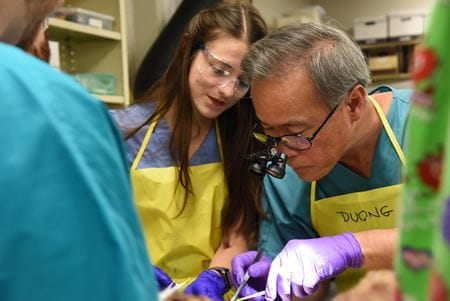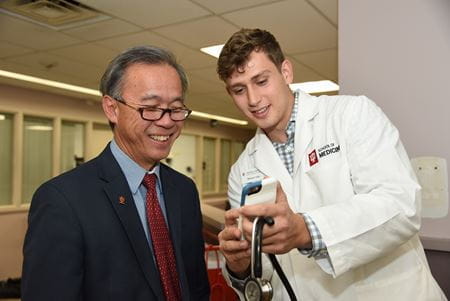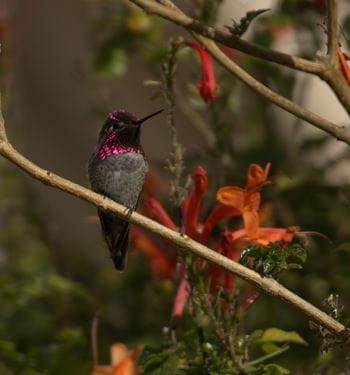As winter starts to thaw each year, thousands of sandhill cranes flock to Linton, Indiana’s Goose Pond on their migratory route back to their northern homes. It’s a favorite annual event for hobby photographers like Taihung “Peter” Duong, PhD, the longtime associate dean and director of Indiana University School of Medicine—Terre Haute.
As he positioned his camera equipment, Duong struck up a conversation with two fellow birders from southwestern Indiana. Turns out their family physician, Adam Rudolph, MD, was a former student in the Rural Medical Education Program that Duong launched in 2008 when he stepped into campus leadership.
“I remember Adam well,” Duong said of the 2018 graduate who now practices in Petersburg, Indiana — population 2,269. “He went to IU Southeast and then came here on the rural track and met his wife in our program. Now she is a pediatrician, and he is a family physician. It was gratifying to meet his patients — this couple next to me who was birding.”
The experience illustrates the impact Duong has made in growing Indiana’s rural physician workforce over the past 17 years. Since its creation, IU’s rural medicine program has produced 177 graduates, most of whom now practice in primary care fields. About 32% of these doctors work in rural areas of Indiana, and 77% practice in areas designated as medically underserved. An Urban Medicine Program, launched at IU School of Medicine—Northwest-Gary in 2022, was patterned after the rural program’s success.
Duong will retire at the end of 2025 — after 34 years on faculty at the IU School of Medicine — leaving a legacy as a dedicated leader who expanded learning opportunities for medical students, recruited key faculty researchers and collaborated with community health partners, benefitting both rural residents and medical trainees.
Duong also helped improve the IU School of Medicine admissions process as associate dean for MD admissions and student financial services and as a 20-year member of the Admissions Committee. Each year, the medical school receives over 6,000 applications for its 365 spots.
“He understood the complexity of admissions evaluations, which goes beyond the assessment of test scores and transcripts to include identifying future physicians whose compassion, resilience and character would serve patients and communities for decades to come,” said Karen Smartt, EdD, MA, assistant dean and director of admissions at the IU School of Medicine. “Thousands of students have passed through our admissions process during his tenure — many now practicing physicians who carry forward the values he helped instill in this institution.”
Alzheimer’s researcher and award-winning teacher
Duong came to IU in 1991 — when the internet was just emerging — after completing a doctorate in anatomy and a postdoc in neuroanatomy at the University of California, Los Angeles. Through his interest in Alzheimer’s disease research, Duong connected with some notable IU faculty, including Bernardino Ghetti, MD, who discovered the first hereditary dementia in 1989 and was just starting to build the Indiana Alzheimer’s Disease Research Center when Duong was recruited to IU.

“I was grateful to have a tenure-track position and a laboratory to start doing my research in, and being able to teach in a small setting,” said Duong, who went from teaching about 120 students at UCLA to an anatomy class of 16 medical students in Terre Haute.
“Of course, going from LA to Terre Haute was a different feel,” said Duong, whose only experience of rural life was in childhood, growing up in the Highlands of South Vietnam. It wasn’t uncommon for his father, a lawyer, to be paid with freshly caught crab or homegrown produce.
Since South Vietnamese men were required to serve in the army when Duong was a youth, he had to apply for the opportunity to study in the U.S. based on his outstanding academic performance. He arrived at Whittier College, located in a suburb of LA, in 1974 and found the nights “too quiet” without the sound of explosions and the supermarkets overwhelming with their many, non-rationed options. A year later, in April 1975, North Vietnamese forces prevailed over South Vietnam in Saigon, leading to the unification of Vietnam under communist rule.
“I lost my citizenship and became a refugee here in the U.S.,” said Duong.
After completing his undergraduate degree, he enrolled at UCLA “without a thought about a career in science” but wanting to further explore his interests in neurobiology.
One professor, Raymond Last, “made anatomy come to life.” Once the personal physician to the Ethiopian Emperor Haile Selassie, Last taught in Australia for half the year and spent the other half at UCLA, where he’d enthusiastically work 12-hour days and offer bonus sessions during school breaks. Duong remembers him excitedly explaining the difference between the “knee” of fruit bats compared to human knees.
“I derive most of my teaching technique from him,” said Duong, himself an eight-time winner of the IU Trustees’ Teaching Award. “You start by showing the big picture, then as you teach, you go down and narrow further into the details.”
Inspiring mentor for physician leaders
Angela Hatfield, MD, a 2015 IU School of Medicine—Terre Haute graduate, calls Duong a “sensitive and thoughtful mentor” who has helped her navigate her educational and professional path with compassion and wisdom.

“I like to say Dr. Duong has been my boss since I was 18,” said Hatfield, now a family medicine doctor in Clinton, Indiana — population 4,802. “He was the director of my undergraduate and medical school rural programs, giving advice on both the steps to obtaining the experiences that would help me gain admission and succeed in medical school, but also providing support and advice as I learned to navigate life as an adult.”
Hatfield, an adjunct clinical assistant professor, now leads the family medicine clerkship for the regional campus.
“Dr. Duong's impact on the IU School of Medicine—Terre Haute campus has been indelible,” she said. “He has been a strong advocate for the unique strengths of this site for decades — building strong, lasting educational programs that provide well-rounded physicians to the areas of Indiana and other rural states that need them the most.”
As Duong prepares for retirement at the end of 2025, he’s intentional about mentoring the people who will assume his longtime leadership roles. Stephanie Sharpe, MD, has been named assistant dean for MD admissions and student financial services, and Robert Ehresman, MD, was named associate director for IU School of Medicine—Terre Haute. Ehresman has been affiliated with the regional campus since he was a medical student — and Duong was his instructor in neuroanatomy.
“I truly believe that a week after I’m gone, there’ll be business as usual,” Duong said of his confidence in the new leaders.
Sharpe, an assistant professor of clinical medical and molecular genetics, has served as co-chair of the Admissions Committee for the past five years and has been shadowing Duong during the transition.
“Under his guidance, she is gaining the insight, judgment and care that have defined his two decades of service,” said admissions director Smartt. “Dr. Duong’s mentorship to new committee members reinforced the values of thoughtful review, and his calm, measured guidance became a model for how to balance rigor with humanity.”
 After Duong retires, he will likely be found outdoors with his camera, capturing a new bird species or photographing majestic celestial bodies in the night sky.
After Duong retires, he will likely be found outdoors with his camera, capturing a new bird species or photographing majestic celestial bodies in the night sky.
“Birds are the flying jewels of our world,” he said, “and the night sky holds so many beautiful mysteries when we look closely.”
Michael W. King, PhD, associate director for research and for Phase 1 education in Terre Haute, has been Duong’s colleague and friend since his arrival at IU in 1991. King called the outgoing campus leader a strong supporter of faculty research, an advocate for medical education and a “phenomenal instructor and mentor.”
“I think the evidence of the success of IU School of Medicine—Terre Haute students speak volumes,” King said. “The compassion and dedication to our students, which has been a constant theme of Dr. Duong’s career and leadership, will be his most significant, lasting legacy.”

